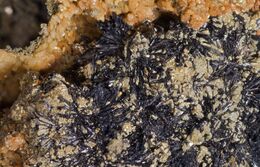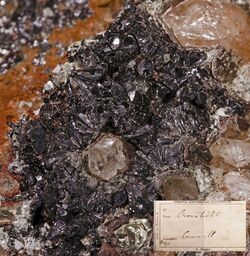Chemistry:Cronstedtite
From HandWiki
Short description: Silicate mineral
| Cronstedtite | |
|---|---|
 Cronstedtite – Salsigne Mine – France | |
| General | |
| Category | Silicate minerals |
| Formula (repeating unit) | Fe2+2Fe3+(Si,Fe3+O5)(OH)4 |
| Strunz classification | 9.ED.15 |
| Crystal system | Trigonal |
| Crystal class | Ditrigonal pyramidal (3 m) (same H-M symbol) |
| Space group | P31m (no. 157) |
| Unit cell | a = 5.486 Å, c = 7.095 Å; Z = 1[1] |
| Identification | |
| Color | Black, dark brown-black, green-black |
| Cleavage | Perfect on {001} |
| Tenacity | Elastic |
| |re|er}} | Sub-Metallic |
| Streak | Dark olive green |
| Diaphaneity | Translucent |
| Specific gravity | 3.34 – 3.35 |
| Optical properties | Biaxial (−) |
| Refractive index | nα = 1.720 nβ = 1.800 nγ = 1.800 |
| Birefringence | δ = 0.080 |
| Pleochroism | Visible |
| Dispersion | r < v moderate |
| References | [1][2][3] |
Cronstedtite is a complex iron silicate mineral belonging to the serpentine group of minerals. Its chemical formula is Fe2+2Fe3+(Si,Fe3+O5)(OH)4.
It was discovered in 1821 and named in honor of Swedish mineralogist Axel Fredrik Cronstedt (1722–1765). It has been found in Bohemia in the Czech Republic and in Cornwall, England .
Cronstedtite is a major constituent of CM chondrites, a carbonaceous chondrite group exhibiting varying degrees of aqueous alteration. Cronstedtite abundance decreases with increasing alteration.[5]

See also
References
- ↑ 1.0 1.1 Webmineral.com
- ↑ Mindat.org
- ↑ American Mineralogical Society
- ↑ Warr, L.N. (2021). "IMA–CNMNC approved mineral symbols". Mineralogical Magazine 85 (3): 291–320. doi:10.1180/mgm.2021.43. Bibcode: 2021MinM...85..291W. https://www.cambridge.org/core/journals/mineralogical-magazine/article/imacnmnc-approved-mineral-symbols/62311F45ED37831D78603C6E6B25EE0A.
- ↑ Browning et al. (1996) Geochimica et Cosmochimica Acta
 |

